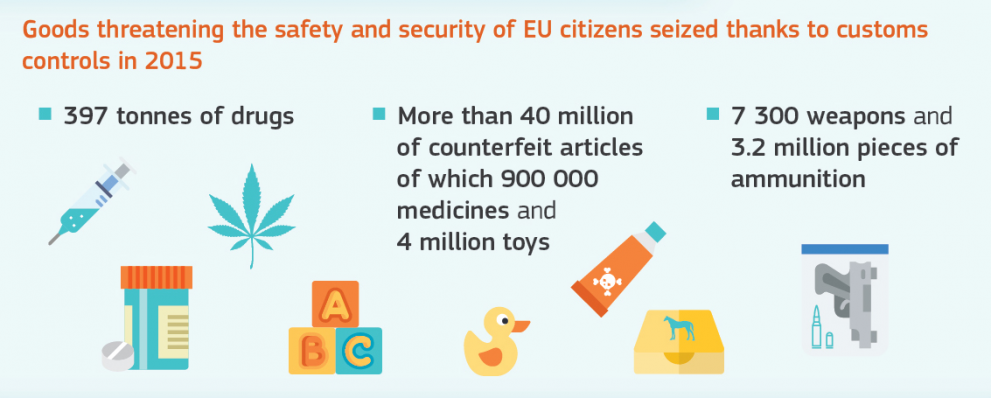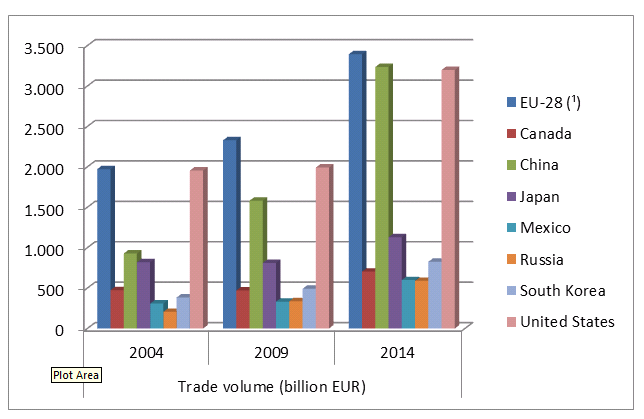Why is Risk Management crucial?
Protect the security and safety of the EU and its citizens
Security is a top priority for the European customs!
The recent terrorist attacks in EU Member States and other countries have reiterated the crucial role that Customs play in border security.
Customs offices control goods, and persons carrying goods, by all means of transport at the EU’s external border.
More information on the common risk criteria for security and safety.

Protect and facilitate legitimate trade
Facts:
- Between 2004 and 2014, and despite the impact of the financial crisis, the value of EU external trade grew by more than 72%.
- More than 90 % of annual world trade (8.4 billion tons of merchandise) is carried by sea, along more than 25,800 global trade lanes.
- More than 20 % of this seaborne trade is unloaded in Europe. There are 25,400 transport nodes world-wide for cargo and passengers moved by air, a substantial proportion of which are linked to more than 250 international airports in the EU.
- The eastern land border is 9,890 km long, with 133 commercial road and rail entry points. There are more than 1,000 customs offices of entry along the entire EU external border.
- In 2014, EU customs processed
- 41.5 million pre-arrival cargo declarations - entry summary declarations or ENS - (15.2% increase since 2011)
- 152.6 million import declarations (9% increase since 2011)
- 109.8 million export declarations (14.38% increase since 2011) and,
- 16.4 million transit declarations (16.4% increase since 2011)
These figures represent an average of 609 declarations per minute handled by the Member States’ customs administrations.

This shows that the workload of customs authorities is in constant evolution. Controlling 100% of the traffic is not a realistic option for the EU. This is why risk management is essential to target the right shipments to control and ensure a smooth flow of legitimate trade at the same time.
Although the bulk of trade is lawful, a study by the World Economic Forum estimates illicit trade to be between 8 % and 15 % of the global GDP. However, the scale of illicit trade is, by nature, difficult to quantify. Its cost to the global economy is considerable and estimated to be over EUR 2.5 trillion, all aspects combined.

More information on facilitation of legitimate trade.
Protect the financial interests of the EU
Customs duties are one of the sources of income for the EU and its Member States. Therefore, Customs authorities have the responsibility to ensure that customs duties are properly applied. The European Commission and the Member States work on establishing common risk criteria and standards for financial risks. Those criteria help customs in all the Member States to target suspicious declarations and apply the correct amount of duties when necessary.
More information on common risk criteria and standards for financial risks.
How does Customs Risk management work?
The Customs Risk Management Framework
The CRMF (Customs Risk Management Framework) aims at providing:
- An equivalent level of protection in customs controls for the whole European Union
- A harmonised application of customs controls by the Member States
- A common approach as regards to setting priorities and allocation of resources
- A proper balance between customs controls and facilitation of legitimate trade
It is based on five pillars:
- The identification and control of high-risk goods movements using common risk criteria;
- The identification of priority control areas subject to more intense controls for a specific period of time;
- The systematic and intensive exchange of risk information between customs through the customs risk management system (CRMS);
- The contribution of Authorised Economic Operators (AEO) in a customs-trade partnership secure and facilitate legitimate trade; and
- Pre-arrival/pre-departure security risk analysis based on cargo information submitted in electronic format by traders prior to arrival or departure of goods in/from the EU specifically to cater primarily for security and safety risks.
See the chronology of the development of customs risk management framework.
The Customs Risk Management Framework in details
The EU’s priorities and strategy on customs risk management
The Strategy and Action Plan annexed to the Communication proposes step-by-step actions to reach a more coherent, effective and cost-efficient EU customs risk management at the external borders.
The Commission, the Member States and the economic operators all have an important and clearly defined role to play in ensuring the successful implementation of the new strategy.
The EU’s priorities and strategy on customs risk management in details
